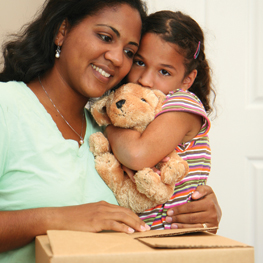
Changing addresses - and sometimes schools, communities and friends - is a rite of passage for millions of children. While a new hometown can be exciting, expansive and fun, it can also make a child’s world feel topsy-turvy. Here’s age-by-age guidance on helping children take a move in stride.
Toddler/Preschool Years Two to Five: Facing Fears
Moves aren’t just hard on older children and teens - very young children are affected by moving too. Toddlers and preschoolers thrive on predictability, so a move that interrupts the daily routine can be distressing, especially if it means parting with a familiar school or day care, a favorite park or a cherished relative. “Some children are very upset by moving,” says Deborah Pardee, Ph.D., psychotherapist and core faculty at the University of the Rockies. “Parents can help in this process by recognizing that the child is going to experience loss and talking about it.”
Assure children that favorite people and places won’t be forgotten by making a memory book full of photos and mementos from the old house and hometown. Little ones may fear forgetting something important at the old house or even of being left behind themselves. Reassure fearful tots that nothing important will be forgotten by discussing how the moving van will deliver all of their toys and furniture to the new house. Show a child maps and driving routes or plane tickets and talk about how all family members (and Fido and Fluffy too) will get to the new hometown, safe and sound.
Elementary Years six to 12: Find the Fun
School-age children are beginning to exercise more control over their lives, and a move can make them feel powerless - after all, they probably had no say in the decision. When Charlotte’s mom Sydney Eggleston moved with her family, she involved Hayden, 14, and Sophia, 12, in as many steps of the process as possible, asking them what they wanted in a new home and embarking on a cross-country ‘treasure hunt’ with them during the actual move.
Help ramp up excitement about the change by creating a new-home wish list together: Does your child dream of living near the beach, skyscrapers or wide-open spaces? Checking out options for amenities like bike trails, skateboard parks and swimming pools can help kids and tweens see the upside of a move.
“The new neighborhood might offer activities and resources not previously available, so a move can be a good time to try something new,” says Paul A. LeBuffe, M.A., director of the Devereux Center for Resilient Children.
“Joining an organization or club, taking a new class or volunteering in the community can provide new experiences, cultivate new interests and provide opportunities for making new friends.”
Teen Years 13 to 18: New Networks
A move can uproot a teen’s social world at a time when relationships are crucial to self-esteem and personal growth. “Peers provide a sense of identity through shared values and interests, as well as a relatively safe context in which to explore a teen’s emerging personality,” says LeBuffe. A long-distance move can put all of this at risk.
Parents can minimize the stress of a move by encouraging teens to use technology to stay close to pals; Eggleston helped arrange Skype calls between her kids and friends. Even with parental help and support, teens may display sadness, withdrawal and resentment toward parents while they adjust to the new setting, says Marilyn B. Benoit, M.D., chief clinical officer at Devereux. This may look like depression, but in most cases, it’s not.
“The ‘normal’ depressive reaction is situational,” she notes.
“A healthy teenager will use resilient coping skills, exploring new relationships and hobbies while staying in touch with old friends.”
Malia is a nationally-published health and parenting journalist and mom of three. Her latest book is Sleep Tight, Every Night: Helping Toddlers and Preschoolers Sleep Well Without Tears, Tricks, or Tirades.
Calgary’s Child Magazine © 2024 Calgary’s Child